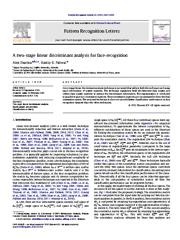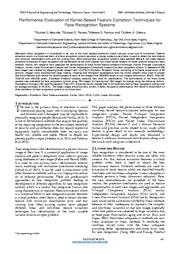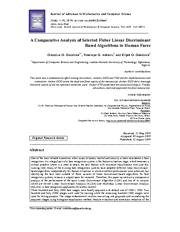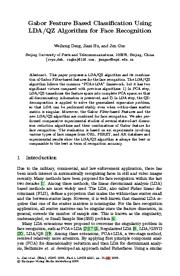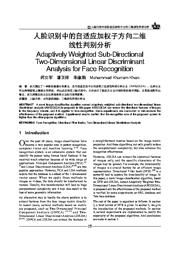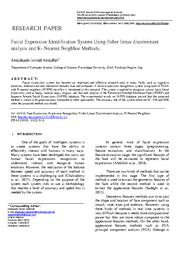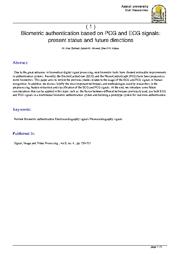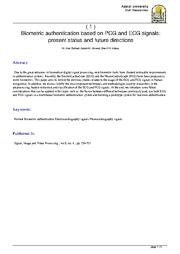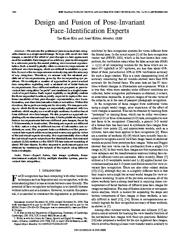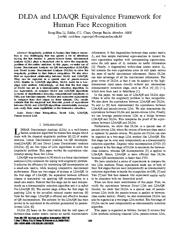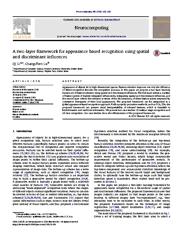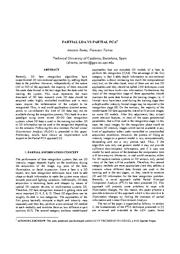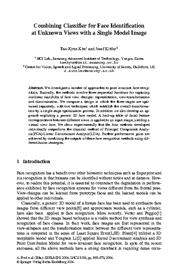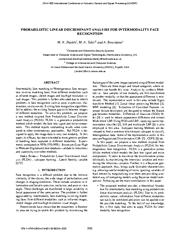A copy of this work was available on the public web and has been preserved in the Wayback Machine. The capture dates from 2013; you can also visit the original URL.
The file type is application/pdf.
Filters
A two-stage linear discriminant analysis for face-recognition
2012
Pattern Recognition Letters
A two-stage linear discriminant analysis technique is proposed that utilizes both the null space and range space information of scatter matrices. ...
The proposed technique is shown to provide better classification performance on face recognition datasets than the other techniques. ...
Introduction Linear discriminant analysis (LDA) is a well known technique for dimensionality reduction and feature extraction (Duda et al., 2000; Sharma and Paliwal, 2006 , 2012 Chen et al., 2000; Lu ...
doi:10.1016/j.patrec.2012.02.001
fatcat:tjwscrg27nhardkktc5t25va24
Performance Evaluation of Kernel-Based Feature Extraction Techniques for Face Recognition System
2019
FUOYE Journal of Engineering and Technology
Analysis) for face recognition system. ...
Most existing face recognition systems have adopted different non-linear feature extraction techniques for face recognition but identification of the most suitable non-linear kernel variants for these ...
Suganya and Menak (2014) carried out an evaluation performance of two important face recognition algorithms namely Principal Component Analysis (PCA) and Linear Discriminant Analysis (LDA). ...
doi:10.46792/fuoyejet.v4i1.285
fatcat:cbrv6s6sbfbv3gpflxyx6mervm
A Comparative Analysis of Selected Fisher Linear Discriminant Based Algorithms in Human Faces
2019
Journal of Advances in Mathematics and Computer Science
and Multiclass Linear Discriminant Analysis (MLDA) in face recognition application for access control. ...
Therefore, this paper carried out a comparative analysis of the performance of the basic Linear Discriminant Algorithm (LDA) and two of its variants which are Kernel Linear Discriminant Analysis (KLDA) ...
Related works [28] presented a novel face recognition system that uses two-class linear discriminant analysis for classification. ...
doi:10.9734/jamcs/2019/v33i430188
fatcat:fnperhqqbneudhl3rax6q7muva
Gabor Feature Based Classification Using LDA/QZ Algorithm for Face Recognition
[chapter]
2006
Lecture Notes in Computer Science
This paper proposes a LDA/QZ algorithm and its combination of Gabor Filter-based features for the face recognition. ...
Moreover, the Gabor Filter-based Features and the new LDA/QZ algorithm are combined for face recognition. ...
Many methods have been proposed for face recognition within the last two decades [1] . Among these methods, the linear discriminant analysis (LDA) based methods are most widely used. ...
doi:10.1007/11881070_3
fatcat:a7fncqjr7fhtzi6ji56jj2pjyi
Adaptively weighted sub-directional two-dimensional linear discriminant analysis for face recognition
2012
Future generations computer systems
discriminant analysis (AWS2DLDA) is proposed in this paper. AWS2DLDA can extract the directional features of images in the frequency domain, and it is applied to face recognition. ...
Adaptively Weighted Sub-Directional Two-Dimensional Linear Discriminant Analysis for Face Recognition 2 Review of DFB R ecently, the new 2-D image representation has become an active research topic. ...
Principal Component Analysis (PCA) [3] [4] [5] and Linear Discriminant Analysis (LDA) [6] [7] [8] [9] [10] are two popular approaches. ...
doi:10.1016/j.future.2010.11.010
fatcat:g57hesycvfgened3w7oj4bs52e
Facial Expression Identification System Using fisher linear discriminant analysis and K- Nearest Neighbor Methods
2019
Zanco Journal of Pure and Applied Sciences
A facial expressions recognition system using each of FLDA with K-nearest neighbors (K-NN) classifier is introduced in this research. ...
A B S T R A C T: Facial expression system has become an important and effective research area in many fields such as cognitive processes, medical care and interaction between man and computer. ...
In the second step, fisher linear discriminant analysis as a feature extraction method is applied to extract the unique features of the face image. ...
doi:10.21271/zjpas.31.2.2
fatcat:bauj5ykrdjcvdj4anku47tlnpe
Biometric authentication based on PCG and ECG signals: present status and future directions
2013
Signal, Image and Video Processing
authentication system and building a prototype system for real-time authentication. ...
This paper aims to review the previous studies related to the usage of the ECG and PCG signals in human recognition. ...
Finally, the classification stage is performed using linear discriminant analysis. ...
doi:10.1007/s11760-013-0593-4
fatcat:ja2xnsnizzf5piykbteq5bxeva
Time-dependent Morphological and Biochemical Changes following Cutaneous Thermal Burn Injury and Their Modulation by Copper Nicotinate Complex: An Animal Model
2012
Ultrastructural Pathology
authentication system and building a prototype system for real-time authentication. ...
This paper aims to review the previous studies related to the usage of the ECG and PCG signals in human recognition. ...
Finally, the classification stage is performed using linear discriminant analysis. ...
doi:10.3109/01913123.2012.685687
pmid:23025652
fatcat:ikmutzb6rvfsvnk6d546so77eu
Design and Fusion of Pose-Invariant Face-Identification Experts
2006
IEEE transactions on circuits and systems for video technology (Print)
Index Terms-Expert fusion, face image synthesis, linear discriminant analysis (LDA), multiple classifier system, pose-invariant face recognition. ...
It is experimentally shown that the individual experts outperform the classical linear discriminant analysis (LDA) method on the XM2VTS face data set consisting of about 300 face classes. ...
Two methods using nonlinear discriminant analysis techniques, which replace the three-stage functions, are also proposed. ...
doi:10.1109/tcsvt.2006.881197
fatcat:dnyxropizjhvhalqzvuqgq3lby
DLDA and LDA/QR equivalence framework for human face recognition
2010
9th IEEE International Conference on Cognitive Informatics (ICCI'10)
In this paper, we make use of Linear Discriminant Analysis via QR decomposition (LDA/QR) and Direct Linear Discriminant Analysis (DLDA) to solve the singularity problem in face feature recognition. ...
A pseudo-inverse linear discriminant analysis (LDA) plays a important role to solve the singularity problem of the scatter matrices. ...
Linear Discriminant Analysis Via QR-Decomposition LDA/QR is a two-stage LDA method [9] . ...
doi:10.1109/coginf.2010.5599743
dblp:conf/IEEEicci/LiCB10
fatcat:nk4kkddl7jbcrctwb6mzdphibi
A two-layer framework for appearance based recognition using spatial and discriminant influences
2013
Neurocomputing
We present two case studies: (i) embryo stage recognition and (ii) face recognition. Our case studies show the effectiveness of the proposed framework. ...
In this paper, we propose a two-layer learning framework of feature selection using spatial and discriminant influences. ...
In the future, we plan to integrate shape analysis with the two-layer framework for object recognition. Table 2 Recognition accuracy (with deviation) on embryo stage recognition. ...
doi:10.1016/j.neucom.2013.03.015
fatcat:d7alsbyxcnevbhydnjnuftjbfq
Partial LDA vs Partial PCA
2006
2006 IEEE International Conference on Multimedia and Expo
Following this new concept, Partial Linear Discriminant Analysis (PLDA) is presented in this paper. Preliminary results have shown an improvement with respect to the Partial PCA approach [1]. ...
This leads to a new paradigm using some mixed 2D-3D face recognition systems where 3D data is used in the training but either 2D or 3D information can be used in the recognition depending on the scenario ...
For this reason, this paper presents a possible extension of this approach which is less sensitive to illumination changes by linking the concepts of partial information and Linear Discriminant Analysis ...
doi:10.1109/icme.2006.262862
dblp:conf/icmcs/RamaT06
fatcat:6cg6ok5zavhfrkmhc2vrmoqcxy
Combining Classifier for Face Identification at Unknown Views with a Single Model Image
[chapter]
2004
Lecture Notes in Computer Science
We show experimentally that the four methods developed individually outperform the classical method of Principal Component Analysis(PCA)-Linear Discriminant Analysis(LDA). ...
We compare a design in which the three stages are optimized separately, with two techniques which establish the overall transformation by a single stage optimization process. ...
The assistance of Kyung-Ah Sohn, a colleague in SAIT, in implementing the algorithms based on the 3D face models is much appreciated ...
doi:10.1007/978-3-540-27868-9_61
fatcat:sog6ubdklvealkfzndihdp3gde
Probabilistic Linear Discriminant Analysis for intermodality face recognition
2014
2014 IEEE International Conference on Acoustics, Speech and Signal Processing (ICASSP)
To solve this problem, we propose a new method inspired from Probabilistic Linear Discriminant Analysis (PLDA). ...
Intermodality face matching or Heterogeneous face recognition involves matching faces from different modalities such as infrared images, sketch images and low/high resolution visual images. ...
In this paper, we propose a new method inspired from Probabilistic Linear Discriminant Analysis (PLDA) for heterogeneous face recognition. ...
doi:10.1109/icassp.2014.6853648
dblp:conf/icassp/ShaikhTB14
fatcat:skptb56jibf5hgvbl2s3d7xl5u
Efficient Discriminate Component Analysis using Support Vector Machine Classifier on Invariant Pose and Illumination Face Images
2015
Research Journal of Applied Sciences Engineering and Technology
This study proposes a novel face recognition algorithm known as Efficient Discriminant Component Analysis (EDCA) for face recognition under varying poses and illumination conditions. ...
The pose and illumination variations are two main practical confronts for an automatic face recognition system. ...
LDA (Linear Discriminate Analysis): The linear combination of fisher's discriminant analysis vectors is called fisher face. ...
doi:10.19026/rjaset.9.1431
fatcat:yosgcojvejdhdokt6y54qgy2y4
« Previous
Showing results 1 — 15 out of 83,168 results

